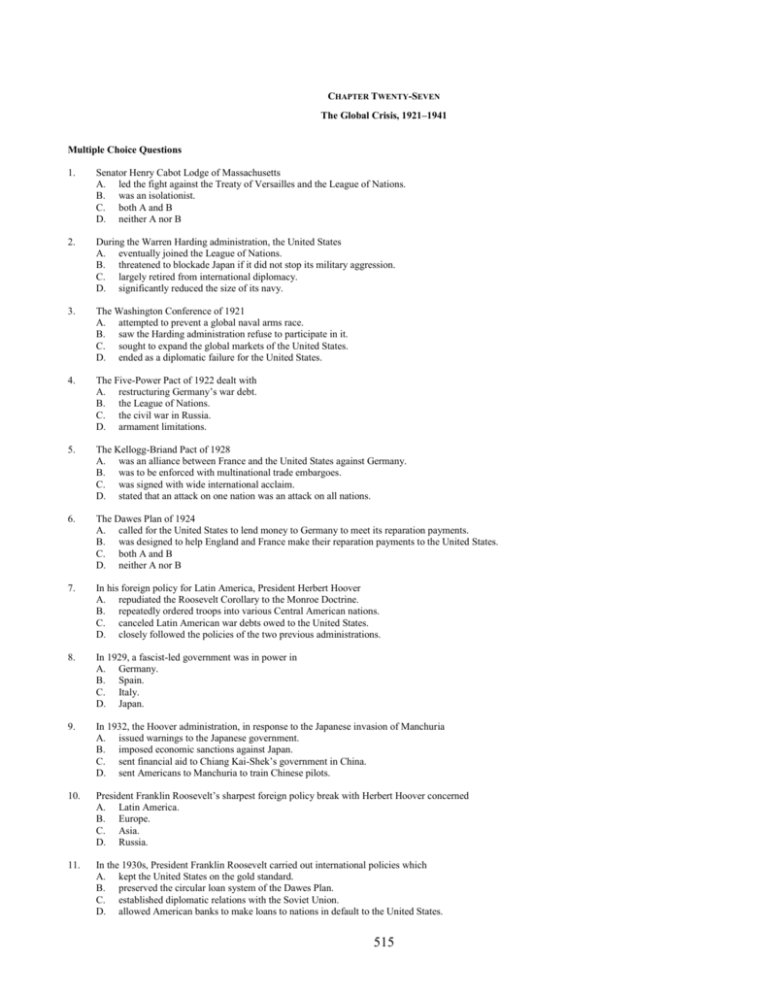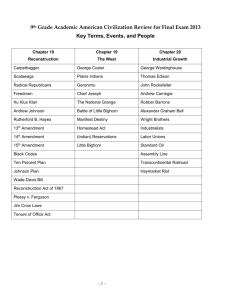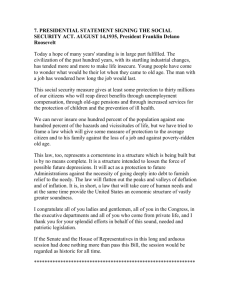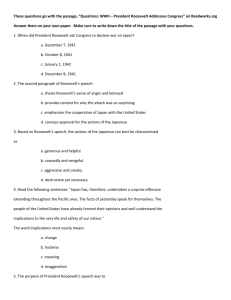Chapter 27 test
advertisement

CHAPTER TWENTY-SEVEN The Global Crisis, 1921–1941 Multiple Choice Questions 1. Senator Henry Cabot Lodge of Massachusetts A. led the fight against the Treaty of Versailles and the League of Nations. B. was an isolationist. C. both A and B D. neither A nor B 2. During the Warren Harding administration, the United States A. eventually joined the League of Nations. B. threatened to blockade Japan if it did not stop its military aggression. C. largely retired from international diplomacy. D. significantly reduced the size of its navy. 3. The Washington Conference of 1921 A. attempted to prevent a global naval arms race. B. saw the Harding administration refuse to participate in it. C. sought to expand the global markets of the United States. D. ended as a diplomatic failure for the United States. 4. The Five-Power Pact of 1922 dealt with A. restructuring Germany’s war debt. B. the League of Nations. C. the civil war in Russia. D. armament limitations. 5. The Kellogg-Briand Pact of 1928 A. was an alliance between France and the United States against Germany. B. was to be enforced with multinational trade embargoes. C. was signed with wide international acclaim. D. stated that an attack on one nation was an attack on all nations. 6. The Dawes Plan of 1924 A. called for the United States to lend money to Germany to meet its reparation payments. B. was designed to help England and France make their reparation payments to the United States. C. both A and B D. neither A nor B 7. In his foreign policy for Latin America, President Herbert Hoover A. repudiated the Roosevelt Corollary to the Monroe Doctrine. B. repeatedly ordered troops into various Central American nations. C. canceled Latin American war debts owed to the United States. D. closely followed the policies of the two previous administrations. 8. In 1929, a fascist-led government was in power in A. Germany. B. Spain. C. Italy. D. Japan. 9. In 1932, the Hoover administration, in response to the Japanese invasion of Manchuria A. issued warnings to the Japanese government. B. imposed economic sanctions against Japan. C. sent financial aid to Chiang Kai-Shek’s government in China. D. sent Americans to Manchuria to train Chinese pilots. 10. President Franklin Roosevelt’s sharpest foreign policy break with Herbert Hoover concerned A. Latin America. B. Europe. C. Asia. D. Russia. 11. In the 1930s, President Franklin Roosevelt carried out international policies which A. kept the United States on the gold standard. B. preserved the circular loan system of the Dawes Plan. C. established diplomatic relations with the Soviet Union. D. allowed American banks to make loans to nations in default to the United States. 515 12. In 1934, the Soviet Union complained that the United States had little interest in stopping the expansion of A. Germany. B. Italy. C. China. D. Japan. 13. President Franklin Roosevelt’s “Good Neighbor Policy” A. expanded initiatives begun under Herbert Hoover. B. was designed to keep the peace in western Europe. C. limited the land purchases by U.S. companies in neighboring countries. D. was abandoned by the United States at the start of World War II. 14. During the 1920s and 1930s, interest in pursuing an isolationist foreign policy A. led the United States to give up its membership in the World Court. B. reflected the sentiments of a majority of the American public. C. led the U.S. Senate to assert that no single nation was a threat to world peace. D. was strongly supported by President Franklin Roosevelt. 15. The Neutrality Act of 1935 A. sought to protect America’s international trade agreements. B. prevented Americans from traveling on ships of warring nations. C. did not prevent the United States from intervening when Italy invaded Ethiopia. D. included a mandatory arms embargo of both sides during any military conflict. 16. The Neutrality Act of 1937 A. stripped the president of many of his powers as commander-in-chief. B. allowed warring nations to purchase goods in the United States if they paid cash. C. loosened the trade policy for England, while tightening it for Germany and Japan. D. banned the sale of all goods from the United States to any nation at war. 17. In 1937, President Franklin Roosevelt’s “quarantine” speech A. saw the president call for further isolation from the nation’s enemies. B. warned Japan it faced a U.S. embargo if it continued to be aggressive. C. saw Roosevelt challenge England and France to limit the aggression of Germany. D. received a decidedly hostile response by the American people. 18. In 1937, after Japanese pilots sank the U.S. gunboat Panay in China, President Roosevelt A. called for an immediate military build-up in the United States. B. entered into an economic alliance with China. C. accepted Japan’s claim that the bombing had been an accident. D. retaliated by bombing Japanese supply depots in China. 19. In 1938, the Anschluss A. proclaimed a union between Germany and Austria. B. caused an uproar in the United States. C. was created at the Munich Conference. D. led France to put its military on alert. 20. The Munich Conference of 1938 was precipitated by a crisis over A. Austria. B. Poland. C. Czechoslovakia. D. Belgium. 21. The Munich agreement of 1938 A. was the result of negotiations involving the League of Nations. B. put most of Poland under German control. C. ended further German aggression until World War II began. D. was supported by President Franklin Roosevelt. 22. Germany began World War II days after A. Germany’s occupation of additional areas of Czechoslovakia. B. a nonaggression pact was signed between Germany and Russia. C. France promised Poland it would provide military support if attacked. D. Germany and Austria were unified. 23. Following the outbreak of war in Europe in 1939, President Franklin Roosevelt A. declared that the United States would remain neutral. B. declared the United States would be the “arsenal of democracy.” C. sent American military advisers to England. D. ordered a “preparedness” campaign much like Woodrow Wilson had in 1916. 516 24. By mid-1940, Germany had defeated A. Norway. B. Denmark. C. France. D. all of the above 25. In 1940, President Franklin Roosevelt’s decision to give fifty American destroyers to England A. was cancelled by Congress. B. ignored the cash-and-carry provision of the Neutrality Acts. C. was in response to requests by the U.S. Ambassador to London, Joseph Kennedy. D. all of the above 26. In July 1940, opinion polls showed the clear majority of the American public A. believed Germany posed a direct threat to the United States. B. were strongly against any involvement by the United States in the war. C. thought the United States should immediately declare war on Germany. D. believed it would be a waste to aid England as that nation would soon fall to Germany. 27. The Burke-Wadsworth Act of 1940 A. reaffirmed the desires of isolationists to stay out of the war. B. approved sending U.S. weapons to England. C. approved the first peacetime draft in American history. D. saw the United States end all trade with any nation allied with Nazi Germany. 28. The America First Committee A. was a powerful lobby against U.S. involvement in the war. B. was opposed by both major political parties. C. called for increased U.S. assistance to England without any actual intervention. D. was made up largely of Democrats who favored diplomacy to end the war. 29. In the election of 1940, Franklin Roosevelt A. selected Harry Truman as his new vice president running mate. B. win an unprecedented, but closely contested, third term. C. both A and B D. neither A nor B 30. In 1940, the “lend-lease” plan A. allowed the U.S. to loan weapons to England to be returned when the war was over. B. saw England agree to allow jobless Americans to enlist in the British military. C. saw England allow the construction of American military bases on British territory. D. saw the U.S. lend funds to the Allies so they could lease war supplies from the U.S. 31. By September 1941 A. Germany had agreed with Japan to fight against the United States. B. the United States extended lend-lease privileges to the Soviet Union. C. President Roosevelt made a secret agreement to send American troops to England. D. Germany claimed it had no interest in engaging America in war. 32. In 1941, the German sinking of the American ship Reuben James A. triggered an American naval campaign against Germany. B. led Congress to approve the arming of American merchant ships. C. both A and B D. neither A nor B 33. In 1941, the Atlantic Charter A. took place in Washington D.C. B. was completed by senior military officials in the United States and England. C. saw President Roosevelt agree to an eventual invasion of Europe to drive out the Nazis. D. saw the United States and England claim to share common principles. 34. The Tripartite Pact was a defensive alliance between A. the United States, England, and Russia. B. the United States, England, and France. C. Japan, Germany, and Italy. D. Japan, Germany, and Austria. 35. In 1941, prior to the Japanese attack on Pearl Harbor A. Japanese troops attacked the Philippines. B. the Japanese developed a new, unbreakable communication code. C. President Franklin Roosevelt froze all Japanese assets in the United States. D. President Franklin Roosevelt ordered Japan’s diplomats to leave Washington. 517 36. Which of the following statements regarding the Japanese attack on Pearl Harbor is FALSE? A. The State department assumed the Japanese would never attack the United States. B. The American aircraft carriers escaped the attack. C. Few American authorities believed Japan was capable of an attack on Pearl Harbor. D. The Japanese suffered light losses in the attack. Answer: A Page: 716 Difficulty: Medium 37. In 1941, Germany’s declaration of war against the United States A. occurred after the United States declared war on it. B. came the same day that Japan attacked Pearl Harbor. C. did not occur until two months after the attack on Pearl Harbor. D. occurred before the United States declared war on it. True/False Questions 38. The United States never joined the League of Nations. 39. During the 1920s, the United States played a very active role in global politics. 40. In 1921, Charles Evans Hughes feared an arms race would develop on the world’s oceans. 41. The Kellogg-Briand Pact declared war illegal. 42. During the 1920s, the United States became increasingly dependent on unstable European economies. 43. Under the Dawes Plan, the United States lent money to European countries to repay war debts owed to the United States. 44. President Hoover upheld the Roosevelt corollary to the Monroe Doctrine. 45. The Hoover administration imposed economic sanctions against Japan for its takeover of Manchuria in the early 1930s. 46. By 1934, every nation but one had stopped making their war reparation payments to the United States. 47 The Good Neighbor Policy of the Roosevelt administration did little to stem the growing American domination of the Latin American economy. 48. The neutrality legislation of the mid-1930s was designed to protect traditional American neutral rights. 49. The United States, Great Britain, and France were united in their opposition to assisting either side in the Spanish Civil War. 50. President Franklin Roosevelt made his “quarantine” speech in an effort to block Hitler’s takeover of Austria. 51. At the time of its announcement, President Roosevelt approved of the Munich agreement. 52. Stalin’s nonaggression pact with Hitler was signed before the start of World War II in Europe. 53. Like Woodrow Wilson before him, President Roosevelt asked the American people to be neutral when war erupted in Europe in 1939. 54. President Roosevelt’s first response to the war in Europe was to request that Congress extend lend-lease to the Allies. 55. By 1940, the American ambassador to Great Britain, Joseph Kennedy, thought that the British cause was hopeless. 56. President Roosevelt’s decision to give American destroyers to Great Britain was consistent with the “cash-and-carry” provisions of the Neutrality Acts. 57. By the time President Roosevelt ran for a third term, a significant majority of the American people believed that Nazi Germany posed a direct military threat to the United States. 58. On foreign policy matters, President Roosevelt and his Republican challenger Wendell Willkie were in essential agreement. 59. Lend-lease to Great Britain led directly to an American decision to convoy goods across the Atlantic Ocean. 60. President Roosevelt responded to the Nazi invasion of Russia by extending lend-lease to Russia. 61. President Roosevelt’s August 1941 meeting with Winston Churchill off the coast of Newfoundland led to a private commitment to use the American military in the war against Hitler. 62. The Roosevelt administration refused to issue economic sanctions against Japan prior to the attack on Pearl Harbor. 518








